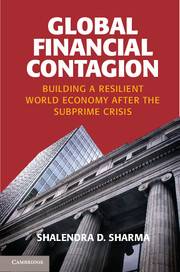Book contents
- Frontmatter
- Contents
- List of Figures
- List of Tables
- Acknowledgments
- Introduction
- One The United States
- Two The Bush and Obama Administrations’ Response
- Three From the U.S. to the European Crisis
- Four The Eurozone’s Sovereign-Debt Crisis
- Five Russia
- Six China
- Seven Japan, South Korea, and India
- Eight The Middle East amid the Global Financial Crisis
- Nine The Great Recession and the World’s Poorest
- Ten G-20 World
- Bibliography
- Index
- References
Two - The Bush and Obama Administrations’ Response
Published online by Cambridge University Press: 05 June 2014
- Frontmatter
- Contents
- List of Figures
- List of Tables
- Acknowledgments
- Introduction
- One The United States
- Two The Bush and Obama Administrations’ Response
- Three From the U.S. to the European Crisis
- Four The Eurozone’s Sovereign-Debt Crisis
- Five Russia
- Six China
- Seven Japan, South Korea, and India
- Eight The Middle East amid the Global Financial Crisis
- Nine The Great Recession and the World’s Poorest
- Ten G-20 World
- Bibliography
- Index
- References
Summary
In September 2008, the U.S. economy (indeed, the global economy) teetered on a precipice of a depression that would rival the scale of the Great Depression. In a matter of weeks, several of the world’s premier financial institutions had collapsed, credit markets had ceased to function, trillions of dollars in household savings had evaporated as stocks, pensions, and home values plummeted, and hundreds of thousands of people had lost their jobs. As widespread feelings of loss, insecurity, and panic gripped the land, authorities jumped into action to avert a large-scale economic depression. Leading the charge for bold and vigorous action was the Federal Reserve’s Ben Bernanke. An economic historian, Bernanke understood the cost of inaction and of inappropriate action. After all, Milton Friedman and Anna Schwartz’s classic A Monetary History of the United States – which has long provided the standard history of U.S. monetary and financial experience – warned about the dangers of both. Friedman and Schwartz had compellingly argued that the crash of 1929 rapidly morphed into the Great Depression because of the Federal Reserve Board’s inept response, which resulted in a large contraction of the U.S. money supply. This view has long been conventional wisdom, to the point that scholars of the Great Depression uniformly blame that era’s policymakers for making a bad situation worse by failing to decisively respond to the unfolding economic crisis. Clearly, Bernanke was determined not to repeat these errors. Seen in this context, Bernanke’s strong support of the Bush, and later the Obama, administrations’ massive stimulus program, including the decision to drive interest rates rapidly down to essentially zero was hardly surprising.
- Type
- Chapter
- Information
- Global Financial ContagionBuilding a Resilient World Economy after the Subprime Crisis, pp. 63 - 101Publisher: Cambridge University PressPrint publication year: 2013



